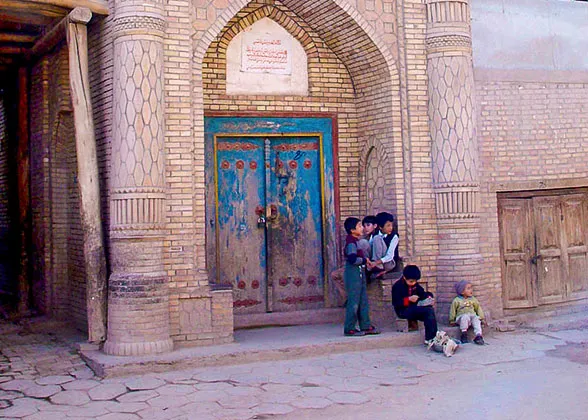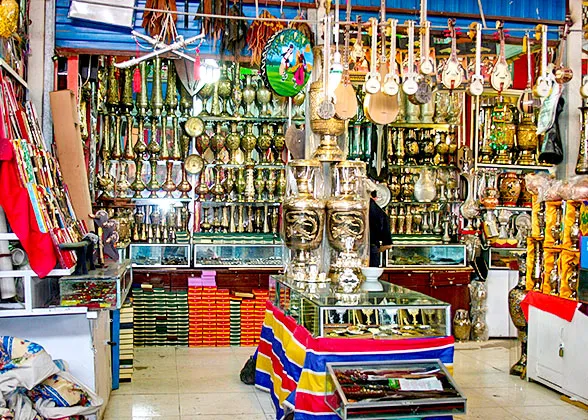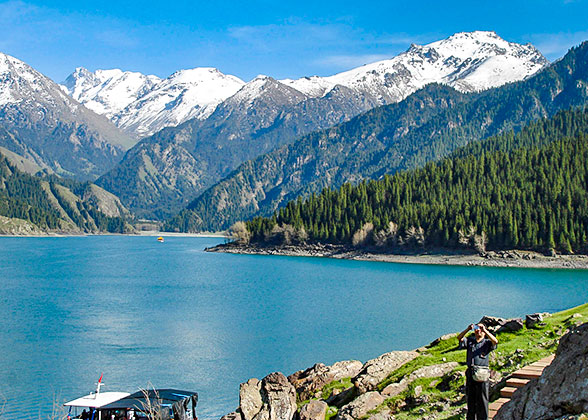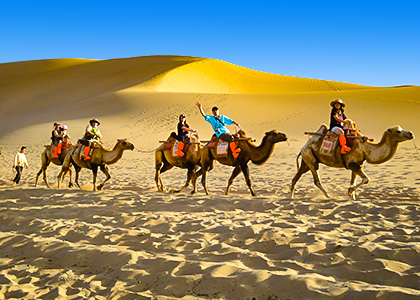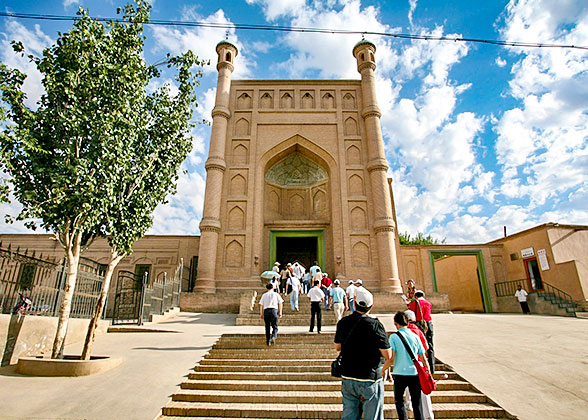Kashgar Weather in March
Season: Winter
In short:
1. Most areas turn warm, except high-altitude areas. However, the temperature is not stable at this time.
2. Precipitation is low, and low-altitude areas even can’t see a single rainfall or snowfall in March in some years.
3. The second half month is a not bad traveling time.
Average Temperature: 2-14°C (35-57°F)
March marks the final month of winter in Kashgar, with most areas transitioning from slightly chilly to relatively warm conditions, particularly during daytime hours. Taking Kashgar City as an example: daily lows at the beginning of the month hover around 0 degrees Celsius (32 degrees Fahrenheit) while daily highs are about only 5-10°C (41-50°F); by mid- and late-month, daily lows and highs rise to around 5-10°C (41-50°F) and 15-20°C (59-68°F), respectively.
Higher-elevation areas remain cold, and winter clothing is needed: Tashkurgan on the Pamir Plateau sees temperature between -15 and -5°C (5-23°F) early in the month, and around -5 to 5°C (23-41°F) by month’s end.
Note that, besides the temperature gap between day and night, the temperature difference between consecutive days can also be quite significant this month. For instance, on March 25th, 2025, Kashgar City experienced relatively warm weather with temperature ranging from 8 to 28°C (46-82°F). However, following a rainy day, the temperature plummeted to 0-7°C (32-45°F) on March 27th. Therefore, checking the daily weather forecast during your trip is crucial.
Low-altitude areas see very low precipitation this month, with some regions potentially experiencing no precipitation throughout the entire month in some years. As for the precipitation patterns, with the temperature rising, these regions may get sleet at the beginning of the month, but mainly light rain since the middle month. The low precipitation causes dry weather of Kashgar, which, together with strong winds, makes dusty weather show up frequently.
High-altitude areas see slightly higher precipitation. Light, moderate, or even heavy snowfall is possible. Toward the end of the month, as temperatures rise, sleet may occur.
Sunrise: 08:42 - 09:29
Sunset: 20:48 - 21:18
Overall, daylight hours in Kashgar gradually lengthen throughout March: daylight lasts approximately 11.5 hours at the beginning of the month, and increases to around 12.5 hours by the month’s end. Sunshine is relatively plentiful, with an average daily sunshine duration of about 6 hours. Note that ultraviolet radiation also intensifies this month. For outdoor visits that involve long-term sun exposure, be sure to take adequate sun protection measures.
See also: Xinjiang Weather in March
Compared with the first half of the month, second half is a better time to visit Kashgar for the following reasons:
(1) The climate of Kashgar in late March is warmer and more favorable, and the daylight hours are longer.
(2) Although the whole month belongs to the slack season, allowing you to enjoy lower hotel and flight prices, more shops in attractions like Kashgar Old Town will open by late March.
(3) Apricot blossoms begin blooming across Kashgar in late March.
(4) Lakes like Baisha Lake and Karakuri Lake start thawing in late March. You even have a chance to spot the unique sight of half-water and half-ice landscapes.
 Clothes for the First Half of the Month: For most areas, hoodies layered under 3-in-1 jackets, paired with jeans and long johns, make for suitable outfits. If you are sensitive to cold, pack a pair of thermal pants for mornings and evenings. However, for high-altitude regions, you still need to bring a down coat and outdoor windproof pants on this basis.
Clothes for the First Half of the Month: For most areas, hoodies layered under 3-in-1 jackets, paired with jeans and long johns, make for suitable outfits. If you are sensitive to cold, pack a pair of thermal pants for mornings and evenings. However, for high-altitude regions, you still need to bring a down coat and outdoor windproof pants on this basis.
 Clothes for the Second Half of the Month: When visiting low-altitude attractions like Kashgar Old Town, Kashgar Bazaar, or Id Kah Mosque in the daytime, you can wear long- or short-sleeved T-shirts, denim jackets, and sweatpants. For evening outings, put on a three-in-one jacket. For high-altitude destinations like the Pamir Plateau, wear a three-in-one jacket or a down jacket, especially in the early morning and at night. For the lower body, long johns and thermal pants are needed.
Clothes for the Second Half of the Month: When visiting low-altitude attractions like Kashgar Old Town, Kashgar Bazaar, or Id Kah Mosque in the daytime, you can wear long- or short-sleeved T-shirts, denim jackets, and sweatpants. For evening outings, put on a three-in-one jacket. For high-altitude destinations like the Pamir Plateau, wear a three-in-one jacket or a down jacket, especially in the early morning and at night. For the lower body, long johns and thermal pants are needed.
 Shoes: Warm and comfortable sneakers or hiking boots are OK, but it’s better if they can keep out sand and dust.
Shoes: Warm and comfortable sneakers or hiking boots are OK, but it’s better if they can keep out sand and dust.
 Others:
Others:
1. Though gloves and scarves are unnecessary, you still need to pack hats for high-altitude attractions, where the wind is a bit strong and cold.
2. Masks are important on dusty days.
3. Remember to bring sunscreen and sunglasses to avoid getting sunburn.
4. Lip balm, hand cream, and body lotion are essential, as the air in Kashgar is extremely dry this month. You’d better bring a portable water bottle to stay hydrated.
1. March sees frequent dusty weather. If you encounter this kind of weather condition during your trip, previously planned outdoor activities may need to be canceled. Therefore, it is advisable to prepare alternative indoor activities beforehand, such as visiting museums or craft shops.
2. Natural landscapes like Baisha Lake appear entirely different on cloudy versus on sunny days. It is recommended to keep an eye on the weather forecast throughout your trip and prioritize visiting these sites on clear days whenever possible.
3. Roads in high-altitude areas such as the Panlong Ancient Road may still be covered by snow and ice sometimes this month, and may occasionally be closed. If your travel plans include these areas, stay updated with the latest information.
4. If you are particularly interested in apricot blossoms, the last a few days of March and early April are the best times for you, as this is typically when the flowers reach full bloom.
In short:
1. Most areas turn warm, except high-altitude areas. However, the temperature is not stable at this time.
2. Precipitation is low, and low-altitude areas even can’t see a single rainfall or snowfall in March in some years.
3. The second half month is a not bad traveling time.
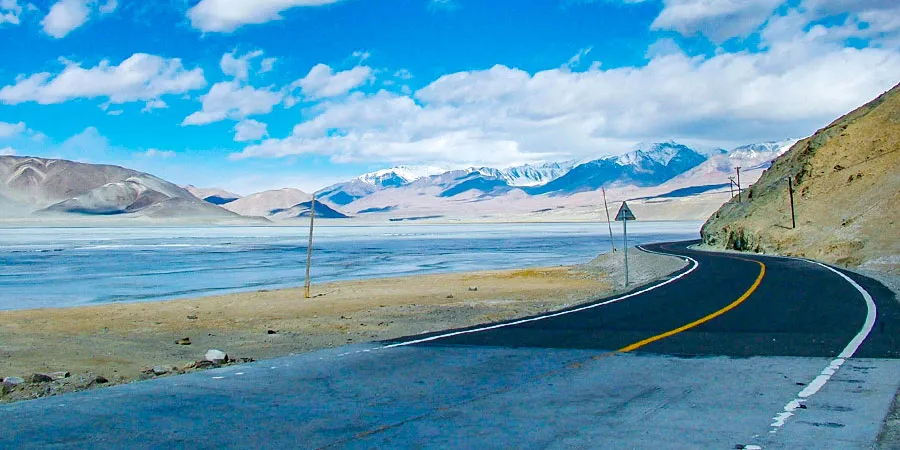 |
| Pamir Plateau on Sunny March Days |
Temperature
March marks the final month of winter in Kashgar, with most areas transitioning from slightly chilly to relatively warm conditions, particularly during daytime hours. Taking Kashgar City as an example: daily lows at the beginning of the month hover around 0 degrees Celsius (32 degrees Fahrenheit) while daily highs are about only 5-10°C (41-50°F); by mid- and late-month, daily lows and highs rise to around 5-10°C (41-50°F) and 15-20°C (59-68°F), respectively.
Higher-elevation areas remain cold, and winter clothing is needed: Tashkurgan on the Pamir Plateau sees temperature between -15 and -5°C (5-23°F) early in the month, and around -5 to 5°C (23-41°F) by month’s end.
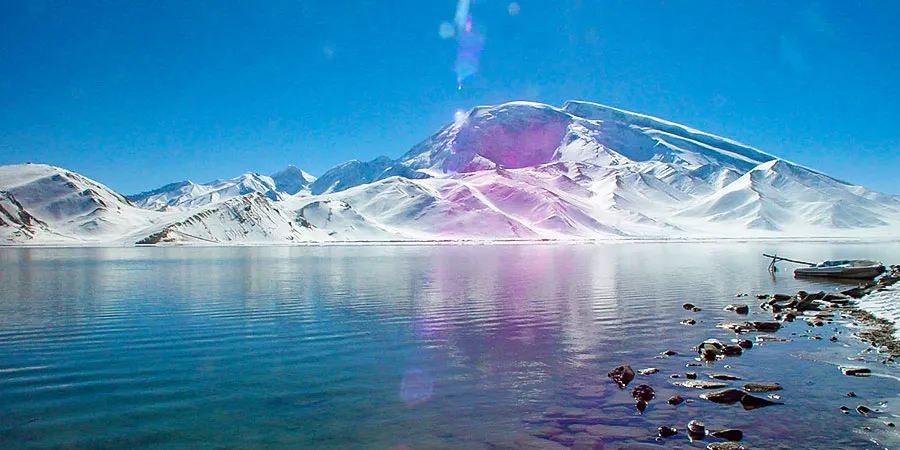 |
| Melting Karakuri Lake |
Note that, besides the temperature gap between day and night, the temperature difference between consecutive days can also be quite significant this month. For instance, on March 25th, 2025, Kashgar City experienced relatively warm weather with temperature ranging from 8 to 28°C (46-82°F). However, following a rainy day, the temperature plummeted to 0-7°C (32-45°F) on March 27th. Therefore, checking the daily weather forecast during your trip is crucial.
Precipitation
High-altitude areas see slightly higher precipitation. Light, moderate, or even heavy snowfall is possible. Toward the end of the month, as temperatures rise, sleet may occur.
Daylight Hours/ Sunshine Hours
Sunset: 20:48 - 21:18
Overall, daylight hours in Kashgar gradually lengthen throughout March: daylight lasts approximately 11.5 hours at the beginning of the month, and increases to around 12.5 hours by the month’s end. Sunshine is relatively plentiful, with an average daily sunshine duration of about 6 hours. Note that ultraviolet radiation also intensifies this month. For outdoor visits that involve long-term sun exposure, be sure to take adequate sun protection measures.
See also: Xinjiang Weather in March
Is March A Good Time to Visit Kashgar?
(1) The climate of Kashgar in late March is warmer and more favorable, and the daylight hours are longer.
(2) Although the whole month belongs to the slack season, allowing you to enjoy lower hotel and flight prices, more shops in attractions like Kashgar Old Town will open by late March.
(3) Apricot blossoms begin blooming across Kashgar in late March.
(4) Lakes like Baisha Lake and Karakuri Lake start thawing in late March. You even have a chance to spot the unique sight of half-water and half-ice landscapes.
|
|
Packing Tips for Kashgar Trip in March 2026
 |
1. Though gloves and scarves are unnecessary, you still need to pack hats for high-altitude attractions, where the wind is a bit strong and cold.
2. Masks are important on dusty days.
3. Remember to bring sunscreen and sunglasses to avoid getting sunburn.
4. Lip balm, hand cream, and body lotion are essential, as the air in Kashgar is extremely dry this month. You’d better bring a portable water bottle to stay hydrated.
Other Tips for Kashgar Trip in March
2. Natural landscapes like Baisha Lake appear entirely different on cloudy versus on sunny days. It is recommended to keep an eye on the weather forecast throughout your trip and prioritize visiting these sites on clear days whenever possible.
3. Roads in high-altitude areas such as the Panlong Ancient Road may still be covered by snow and ice sometimes this month, and may occasionally be closed. If your travel plans include these areas, stay updated with the latest information.
4. If you are particularly interested in apricot blossoms, the last a few days of March and early April are the best times for you, as this is typically when the flowers reach full bloom.
7-Day Kashgar Weather Forecast
Kashgar Weather by Month
Recommended Tours
- Last updated on Oct. 27, 2025 by Demi Li -
